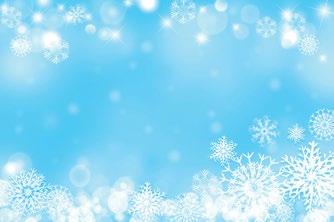
10 minute read
p.m. at Christ Church Trinity in Invermere
PERSPECTIVE
Snowflakes: minute miracles of nature
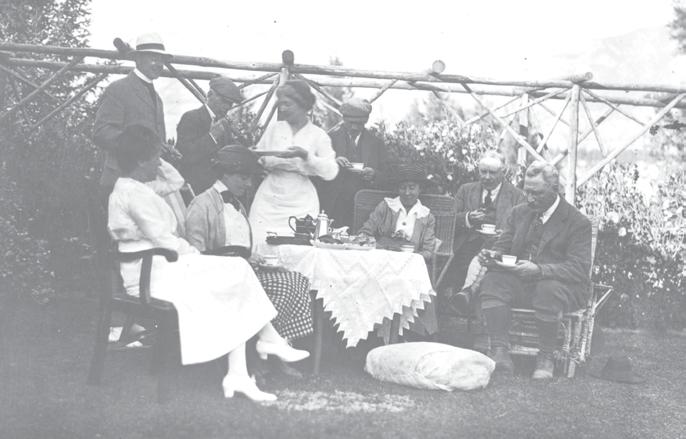
Getty Images
By Joanne McQuarrie editor@columbiavalleypioneer.com
Have you ever taken the time to look closely at a snowflake? Their intricate shapes are a marvel of nature and in this area, there are plenty of snowflakes to check out.
‘Plenty’ of snowflakes translates to a septillion snowflakes; that’s how many fall on Canada each year, said David Phillips, Environment Canada’s senior climatologist. (Digital Citizen) A septillion is a trillion trillion.
For each one of those tiny, complex shapes to form, a series of steps need to happen to form the tiny, complex shapes they become.
Snowflakes start as a single ice crystal which falls through the earth’s atmosphere as snow, reads Wikipedia. Each flake nucleates around a dust particle in supersaturated air masses by attracting supercooled cloud water droplets, which freeze and fuse in crystal form. The complex shapes emerge as the flakes moves through differing temperature and humidity zones in the atmosphere.
There are eight broad classifications and at least 80 individual variants. The main constituent shapes for ice crystals, which combinations form from, are needle, column, plate and rime. Snow appears to be white although is made of clear ice; that is due to diffuse reflection of the whole spectrum of light by the crystal facets in snowflakes.
The shape of a snowflake is determined broadly by the temperature and humidity it is formed in. Often, there’s a six-fold radial symmetry, which gives the snowflake the shape of a hexagon. Then the six ‘arms’ of the snowflake (or dendrites) grow independently from each of the corners of the hexagon; either side of the each arm grows independently. As that formation falls through the aforementioned atmosphere, changes in temperature and humidity affect the way water molecules attach to the snowflake and that determines its shape.
And that’s how the septillion flakes that fall in Canada each year, come about. Each skiff of snow, all around us, has countless amazing shapes in it, to look at. It’s just one of many miracles the earth presents to us.
Historical Lens Historical Lens
Invermere near #4 hole of the first golf course on Fort Point. Tea party noted in Charlie Ellis’s diary. Circa 1915 Courtesy of Windermere District Historical Society
Invermere sticks to new year for Step Code 3
District pursues grant to purchase e-vehicles for municipal fleet
By Steve Hubrecht steve@columbiavalleypioneer.com
The provincial government is wavering about making B.C. Energy Step Code Step 3 standards mandatory first thing in the new year, but the District of Invermere will go ahead and make it a requirement for all local new builds here.
Invermere mayor, Al Miller, clarified the move during the Tuesday, December 13 Invermere council meeting, noting that the district had previously said it would adopt Step 3 when the rest of B.C. did. That was supposed to happen January 1, but as Miller explained, “The province has been waffling somewhat on the start date...however Jan. 1 is still on our books (in Invermere) as the right date to go ahead with Step 3.”
The district sought clarification from the province on when B.C. would go to Step 3, outlined chief administrative officer (CAO), Andrew Young, “but they didn’t really provide it. They just said it wouldn’t be on Jan. 1.” Young added that, for Invermere, “it’s time to move on.”
Miller said the move would not likely have a big effect here in Invermere, since most home builders are already building to the standards of Step 3.
In another move, also discussed at the Dec. 13 meeting and also aimed at making the district a bit more environmentally friendly, council gave its blessing for Invermere staff to pursue a grant that, if successful, would see two electric vehicles purchased for the municipal fleet and would put an array of solar panels on top of the Invermere courthouse.
Invermere environmental planner, Anne-Sophie Corriveau, explained the e-vehicles and solar array would be an opportunity for the district to reduce its greenhouse gas emissions.
The grant is through the Columbia Basin Trust (CBT)’s Basin Charge Up program and would cover 60 per cent ($87,000) of the total project costs of $142,000 for the e-vehicles and solar setup. The remaining 40 per cent ($55,000) would come from the district’s public works and machinery reserve fund or its environmental reserve fund, as well as from provincial and federal e-vehicle rebates worth up to $9,000.

CANADIAN COMMUNITY NEWSPAPER AWARD 2013
The Columbia Valley Pioneer
is independently owned and operated, published weekly by Robert W. Doull, President and Publisher, Misko Publishing Limited Partnership. Box 868, #8, 1008 - 8th Ave., Invermere, B.C. V0A 1K0 Phone: 250-341-6299 | Toll Free (866) 496-8047 info@columbiavalleypioneer.com | www.columbiavalleypioneer.com
The Columbia Valley Pioneer is available free of charge at 13 essential businesses in the Upper Columbia Valley, limited to one copy per reader. This publication has been made possible, in part, by the Government of Canada and the support of our advertisers and is published every Thursday. The Columbia Valley Pioneer may be distributed only by its authorized contractors and employees. No person may, without the prior written consent of The Pioneer or its Publisher, take more than one copy of each issue of The Pioneer. The content is protected by copyright. Reproduction by any means is prohibited except with the permission of the Publisher.
THE WILD FILES It’s our nature
By Chadd Cawson Local Journalism Initiative Reporter
2018 Gold Plate Award
2019 Gold Plate Award
You may know Dasher, Dancer, Prancer and Vixen, Comet, Cupid, Donner, and Blitzen - and you may have even heard of the most famous reindeer of all. But did you know that if Santa had set up his workshop in Canada or the U.S., we’d be singing a very different song?
Reindeer and caribou are the same animal and a member of the deer family, hence the name ‘reindeer’. It’s the term for them in Europe and other parts of the world, while in North America, when wild, we call this creature ‘caribou’. Yet if domesticated, like on a breeding farm, we refer to them as reindeer. Areas in Peace Arch B.C. and the North West Territories are both known for having domesticated reindeer farms.
Corky the Crimson-nosed caribou
If Santa’s red and white suit were to represent he was Canadian, a famous Christmas carol may have needed some adjusting - but all the features of this majestic creature would remain the same. Adult caribou or reindeer range from 80 cm to 150 centimetres (cm) at the shoulder and are the only member of the deer family where both the males (bulls) and females (cows) grow antlers. These antlers are the heaviest of all deer species. A bull’s antlers can be up to 130 cm in length, while a cow’s antlers are less than half as long, at 51 cm. Pregnant caribou will keep their antlers until after they have given birth in the spring. The purpose of a cow’s antlers is to be used to defend food which is vital during their pregnancy. Mountain caribou can be seen throughout the Columbia Basin. In groups they are referred to as herds and in the wild have a life expectancy of 15 years, while those chosen for Santa’s sleigh live forever.
The speed of flight
It was an easy choice for old St. Nick to use this species to guide his sleigh on Christmas Eve - they sure do fly! Caribou can reach speeds of up to 80 km/hr. It’s a good thing too, as the average caribou eats about five kilograms (kg) of food per day. Caribou are herbivores and live off ruffage and lichens (primary winter forage) when vegetation is scarce. While caribou prefer their vegetation, they have been known to nibble on discarded antlers and lemmings, when they are in abundance. Known for their unique hooves with four toes on each foot, they act like snowshoes, giving them the ability to distribute their weight and float over wetlands, soft ice, and snow as if it were a cloud in the sky - ideal for gift delivery in all the world’s seasons.
Cariblues
According to State of the Basin’s website, mountain caribou saw a major decline throughout the Columbia Basin region from the mid-nineties all the way up to 2017. There has been some fluctuation in numbers, like when herds in the Purcell Mountains were relocated to the North Columbia herd in 2019. After that initiative, the federal minister of environment and climate change determined that the mountain caribou population that once thrived throughout our valley, faced imminent threats. The Government of British Columbia has made efforts since to rectify this by limiting public recreation in caribou habitats, constructing maternal pens, transplanting animals, and predator control. Aside from mankind, who love to hunt caribou for its meat and hides, they are also prey for grizzly bears, wolverines and wolves.
Will you be my bou?
Bulls have many mates during caribou mating season, which starts in mid-October. Most cows give birth to a single calf after a 230-day gestation period in late May or June. If you want to inspire a lazy kid, ask them why can’t they be more like a caribou: after only two hours that a calf is born, they are up and running at a speed faster than most Olympic runners. Look out Ben - here comes Blitzen!
Spirited species
Caribou or reindeer don’t only have a special role to fill at the North Pole. They are also very special in Indigenous cultures. They have not only been a good source for food or to make clothing like tufting, they are also considered a spiritual ancestor and gift from the Creator and most importantly, a neighbor. Watch out for Santa’s happy herd this Christmas Eve!
The Christmas Dinner Feast
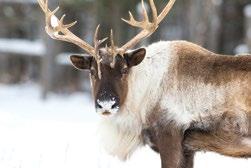
Christmas Hours
We would LOVE to cook you a proper feast to enjoy in the comfort of your home. It’s our present to you — we do all the work while you take the credit! Order for Pickup Dec 23 or 24 (Open till 2pm on the 24th)
Don’t worry; we include re-heating instructions for you.
Celeriac Soup
With roasted hazelnuts & fresh pear
MENU OPTIONS OR Winter Greens Salad
With kale, radicchio, pomegranate, goats’ cheese & pinenuts
Roast Turkey
Wood oven roasted with herb stuffing, carrot & parsnip puree, rosemary & garlic wood oven roasted potatoes, gravy, & cranberry sauce
OR Glazed Ham
Apple cider, mustard & sage glaze, with herb stuffing, carrot & parsnip puree, rosemary & garlic wood oven roasted potatoes, gravy, & cranberry sauce
OR Risotto
Wild Mushroom & Truffle, finished with Parmesan cheese & fresh herbs Mon, Dec 19 .................................CLOSED Tue, Dec 20 – Fri, Dec 23 ....... 12pm – 8pm Sat, Dec 24 ............................. 9am – 2pm ..........................Christmas Dinner Pick ups Sun, Dec 25 ..................................CLOSED .......................................Merry Christmas! Mon, Dec 26 .................................CLOSED Tue, Dec 27 ........................... 12pm – 8pm Wed, Dec 28 ......................... 12pm – 8pm Thu, Dec 29........................... 12pm – 8pm Fri, Dec 30............................. 12pm – 8pm Sat, Dec 31 ....................12pm – 4pm/6pm ............. Kitchen Party – Reservations only! Sun, Jan 1 .....................................CLOSED
CHRISTMAS DINNER FEAST
Gingerbread Cake
With caramel sauce & sugared cranberries $5495* person
*Includes applicable taxes & 18% service charge. Ingredients are subject to availability and may change without notice. Dietary requirements can usually be met.
Unit 8, 5019 Fairmont Resort Road | 250.345.0008 | www.fromscratchfood.com

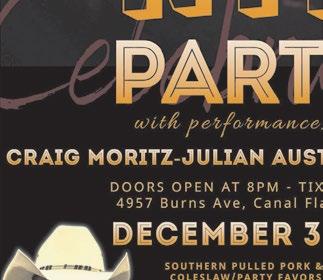
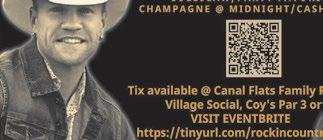
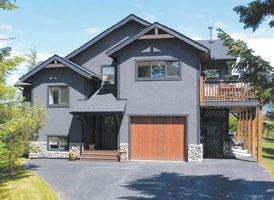
OPEN HOUSE Tuesday, December 27, 2022 • 12 p.m.– 3 p.m.
In case you’re tired of holiday leftovers and family…
Let me show you 816 Lakeview Meadows Green, a lovely 4 bedroom, 3 bathroom home – move-in ready! And yes, there will be cookies.


